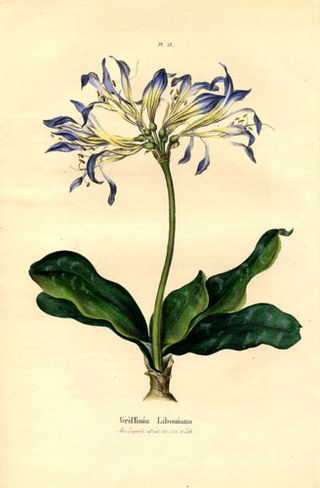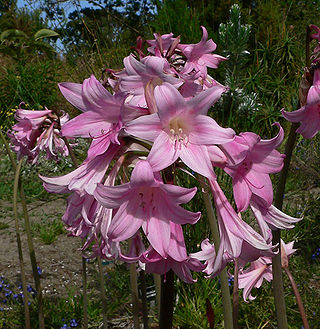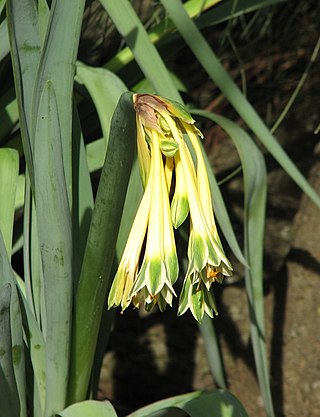
Tigridia, is a genus of bulbous or cormous flowering plants belonging to the family Iridaceae. With common names including peacock flowers, tiger-flowers or shell flowers, they have large showy flowers; and one species, Tigridia pavonia, is often cultivated for this. The approximately 60 species in this family grow in the Americas, from Mexico down to Chile.

Eucrosia is a genus of herbaceous, perennial and bulbous plants in the Amaryllis family distributed from Ecuador to Peru. The name is derived from the Greek eu, beautiful, and krossos, a fringe, referring to the long stamens. As circumscribed in 2020, the genus contains six species. Phaedranassa and Rauhia are the genera most closely related to Eucrosia.

Pamianthe is a genus of South American bulbous perennials in the Amaryllis family, subfamily Amaryllidoideae. They can be found in sandy, but rocky areas in Colombia, Ecuador, Peru, and Bolivia.

Phaedranassa tunguraguae is a species of plant that is endemic to Ecuador. Its natural habitats are subtropical or tropical moist montane forests and subtropical or tropical dry shrubland. It is threatened by habitat loss.

Ismene, or Peruvian daffodil, is a genus of South American plants in the Amaryllis family. The species are native to Peru and Ecuador and widely cultivated elsewhere as ornamentals because of their large, showy flowers.

Galactia is a genus of plants in the legume family (Fabaceae). It belongs to the subfamily Faboideae and tribe Diocleae They do not have an unambiguous common name, being commonly called milk peas, beach peas or wild peas. They are perennial herbs or subshrubs with prostrate, climbing, or erect forms.

Griffinia is a genus of Brazilian plants in the Amaryllis family, subfamily Amaryllidoideae. It includes 23 known species which are endemic to Brazil. The most closely related genus to it is the monotypic Worsleya.

The Amaryllidaceae are a family of herbaceous, mainly perennial and bulbous flowering plants in the monocot order Asparagales. The family takes its name from the genus Amaryllis and is commonly known as the amaryllis family. The leaves are usually linear, and the flowers are usually bisexual and symmetrical, arranged in umbels on the stem. The petals and sepals are undifferentiated as tepals, which may be fused at the base into a floral tube. Some also display a corona. Allyl sulfide compounds produce the characteristic odour of the onion subfamily (Allioideae).

Pyrolirion, commonly known as fire lilies or flame lilies, is a small genus of herbaceous, bulb-forming South American plants in the Amaryllis family, native to Chile, Peru, and Bolivia.

Stenomesson is a genus of bulbous plants in the family Amaryllidaceae. All the species are native to western South America.

Clinanthus is a genus of bulbous plants in the family Amaryllidaceae. It is found in western South America, including Ecuador, Peru, Bolivia, north Chile and north west Argentina.

Amaryllidoideae is a subfamily of monocot flowering plants in the family Amaryllidaceae, order Asparagales. The most recent APG classification, APG III, takes a broad view of the Amaryllidaceae, which then has three subfamilies, one of which is Amaryllidoideae, and the others are Allioideae and Agapanthoideae. The subfamily consists of about seventy genera, with over eight hundred species, and a worldwide distribution.

Rauhia is a genus of Peruvian plants in the Amaryllis family.

Urceolina is a genus of South American plants in the amaryllis family native to Bolivia, Brazil, Colombia, Costa Rica, Ecuador, Guatemala, Panama, and Peru. It has also been introduced to many South and Central American states, as well as India and Sri Lanka. The formerly accepted genera Eucharis and Caliphruria are now regarded as synonyms of this genus. Many species of this genus share the common name Amazon lily.

Leptochiton is a genus of South American plants in the Amaryllis family.

Eucharideae is a tribe of plants within the family Amaryllidaceae. It was augmented in 2000 by Meerow et al. following a molecular phylogenetic study that revealed that many elements of the tribe Stenomesseae segregated with it, rather than separately, and were subsequently submerged in it. Further revisions were made in 2020, when three genera were merged. It forms one of the tribes of the Andean subclade of the American clade of the subfamily.

Clinantheae is a tribe, where it forms part of the Andean clade, one of two American clades. The tribe was described in 2000 by Alan Meerow et al. as a result of a molecular phylogenetic study of the American Amaryllidoideae. This demonstrated that the tribe Stenomesseae, including the type genus Stenomesson was polyphyletic. Part of the tribe segregated with the Eucharideae and were submerged into it, while the other part formed a unique subclade. Since the type species of Stenomesson was not part of the second subclade, it was necessary to form a new name for the remaining species together with the other genera that remained. This was Clinanthus, the oldest name for these species, and consequently the tribe Clinantheae.
Trihesperus is a small genus of flowering plants in the family Asparagaceae, generally found in the Andes of Colombia, Ecuador, Peru, Bolivia, and northwest Argentina. Veitch Nurseries developed a cultivar of Trihesperus latifolius with striped foliage which they called Anthericum latifolium albo media pictum.
Stenomesson korsakoffii is a species of plant in the family Amaryllidaceae native to Peru. It was formerly known as Caliphruria korsakoffii and Urceolina korsakoffii, but a 2020 molecular phylogenetic study indicates that this species is sister to the other species of Stenomesson.
















